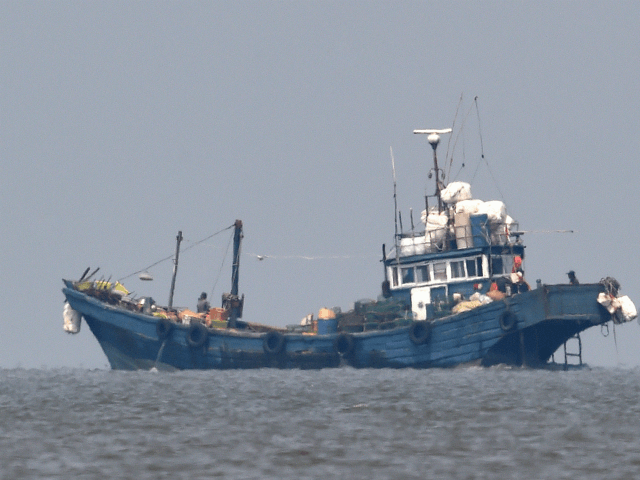China has flooded parts of the Philippines with “fishing vessels” that in reality serve as parts of a sprawling paramilitary intended to give Beijing control of the entire South China Sea, the Philippine Star reported on Monday.
The Star cited the analysis of Gregory Poling, director of the Washington-based Asia Maritime Transparency Initiative (AMTI), which compiles satellite data in the South China Sea to track China’s illegal construction in the region. The AMTI is part of the broader Center for Strategic and International Studies (CSIS).
Poling explained to a Philippine audience on Friday that no evidence exists that China’s “fishing” vessels near Subi Reef, a Philippine territory claimed by China, are in the region to fish.
“Now I mentioned the maritime militia, paramilitary forces, however, we would like to categorize them because I seem to have an impression… that this is a relatively minor part of the Chinese arsenal and we are at a mistake,” Poling explained. “We never see any evidence that they are doing anything [other] than intimidating the neighbors.”
According to Poling, China’s “fishing” ships have “established 24/7 constant presence of naval and coast guard vessels, as well as maritime militia.”
The vessels’ main objective, Poling argued, is to “intimidate” Philippine vessels out of the region. They reportedly average 51 meters in length, significantly bigger than the fishing boats typically used in the area, and stake out traditional Philippine waters to force real fishing vessels to flee. Philippine fishing boats then have to contend with the risk of having to pass by Chinese ships in their own waters and risk ramming or seizure, which has a chilling effect on how many domestic ships use the maritime territory.
The AMTI has repeatedly highlighted the Subi Reef area as one of particular concern. Subi Reef is a formation in the Spratly Islands, mostly part of Philippine sovereign territory. Vietnam and Taiwan also lay some claims to the region, though Vietnam has a larger stake in the Paracel Islands, which China has also colonized. China has deployed its “fishing vessels” and large construction crews to reefs and islands in the area, building artificial islands and equipping them with military and surveillance assets.
The Permanent Court of Arbitration at the Hague ruled China’s claims to the region – which also include the sovereign territory of Malaysia, Indonesia, and Brunei – illegal in 2016. The Chinese Communist Party responded by vowing to ignore the court. Most of the affected nations have done little to challenge China to accept the ruling.
U.S. observers of the South China Sea have warned of China’s growing paramilitary presence in the region for years, independent of protests that China was building illegal facilities in the region. In 2017, Andrew Erickson, a professor at the U.S. Naval War College’s China Maritime Studies Institute, warned that China was using three different military entities – “a regular navy, the police navy, and the sneaky navy” – to control the South China Sea, the latter being the paramilitary group. At the time, China was estimated to boast thousands of personnel assigned to its paramilitary “fishing” vessels.
The U.S. government has protested in the past that U.S. ships, particularly U.S. Navy ships working on legal Freedom of Navigation Exercises (FONOPs), become the targets of paramilitary surveillance.”
“Every vessel [sent on a freedom of navigation transit] is shadowed” by a Chinese ship, retired Marine Lt. Gen. Wallace “Chip” Gregson said at a 2017 event.
FONOPs serve to assert the international, open use nature of waters that fall outside the exclusive sovereign territory of any particular nation. The U.S. Navy uses these exercises in the South China Sea in territory that the Hague ruling asserted did not belong to China, but also does not officially fall within only one of its neighboring countries.
In August, the Pentagon released an annual report on China warning that the People’s Armed Forces Maritime Militia (PAFMM), the paramilitary force, was growing in influence in Vietnamese and Philippine waters. The paramilitary force is named as such because it consists of officially civilian staffers, not members of the People’s Liberation Army (PLA), despite engaging in military activity.
“China … is willing to employ coercive measures to advance its interests and mitigate other countries’ opposition,” the Pentagon warned, using a 2017 example in which the PAFMM “planted a flag on Sandy Cay, a sandbar within 12 nautical miles of Subi Reef and Thitu Island.”
Reports noted that the Pentagon expressed concern that, by sheer number of vessels and personnel, “Beijing has what is clearly the world’s largest and most capable maritime militia.”

COMMENTS
Please let us know if you're having issues with commenting.